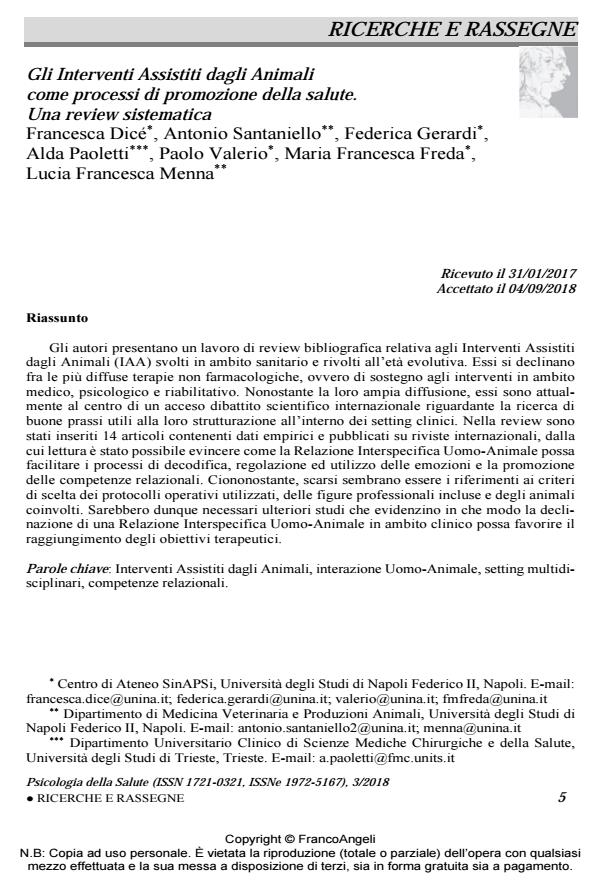Gli Interventi Assistiti dagli Animali come processi di promozione della salute. Una review sistematica
Titolo Rivista PSICOLOGIA DELLA SALUTE
Autori/Curatori Francesca Dicé, Antonio Santaniello, Federica Gerardi, Alda Paoletti, Paolo Valerio, Maria Francesca Freda, Lucia Francesca Menna
Anno di pubblicazione 2018 Fascicolo 2018/3
Lingua Italiano Numero pagine 19 P. 5-23 Dimensione file 223 KB
DOI 10.3280/PDS2018-003001
Il DOI è il codice a barre della proprietà intellettuale: per saperne di più
clicca qui
Qui sotto puoi vedere in anteprima la prima pagina di questo articolo.
Se questo articolo ti interessa, lo puoi acquistare (e scaricare in formato pdf) seguendo le facili indicazioni per acquistare il download credit. Acquista Download Credits per scaricare questo Articolo in formato PDF

FrancoAngeli è membro della Publishers International Linking Association, Inc (PILA)associazione indipendente e non profit per facilitare (attraverso i servizi tecnologici implementati da CrossRef.org) l’accesso degli studiosi ai contenuti digitali nelle pubblicazioni professionali e scientifiche
Gli autori presentano un lavoro di review bibliografica relativa agli Interventi Assistiti dagli Animali (IAA) svolti in ambito sanitario e rivolti all’età evolutiva. Essi si declinano fra le più diffuse terapie non farmacologiche, ovvero di sostegno agli interventi in ambito medico, psicologico e riabilitativo. Nonostante la loro ampia diffusione, essi sono attualmente al centro di un acceso dibattito scientifico internazionale riguardante la ricerca di buone prassi utili alla loro strutturazione all’interno dei setting clinici. Nella review sono stati inseriti 14 articoli contenenti dati empirici e pubblicati su riviste internazionali, dalla cui lettura è stato possibile evincere come la Relazione Interspecifica Uomo-Animale possa facilitare i processi di decodifica, regolazione ed utilizzo delle emozioni e la promozione delle competenze relazionali. Ciononostante, scarsi sembrano essere i riferimenti ai criteri di scelta dei protocolli operativi utilizzati, delle figure professionali incluse e degli animali coinvolti. Sarebbero dunque necessari ulteriori studi che evidenzino in che modo la declinazione di una Relazione Interspecifica Uomo-Animale in ambito clinico possa favorire il raggiungimento degli obiettivi terapeutici.
Parole chiave:Interventi Assistiti dagli Animali, interazione Uomo-Animale, setting multi-disciplinari, competenze relazionali.
- The Semiotic Paradigm in Psychology. A Mature Weltanschauung for the Definition of Semiotic Mind Raffaele De Luca Picione, in Integrative Psychological and Behavioral Science /2020 pp.639
DOI: 10.1007/s12124-020-09555-y - Exploring emotions in dialog between health provider, parent and child. An observational study in pediatric primary care Francesca Dicé, Pasquale Dolce, Assunta Maiello, Maria Francesca Freda, in Pratiques Psychologiques /2020 pp.69
DOI: 10.1016/j.prps.2018.12.001 - Foundation of Ethics-Based Practices Raffaele De Luca Picione, Maria Francesca Freda, Livia Savarese, pp.115 (ISBN:978-3-030-83665-8)
- A Systematic Review of Metacognitive Beliefs in Chronic Medical Conditions Vittorio Lenzo, Alberto Sardella, Gabriella Martino, Maria C. Quattropani, in Frontiers in Psychology 2875/2020
DOI: 10.3389/fpsyg.2019.02875 - The Semiotic Construction of the Sense of Agency. The Modal Articulation in Narrative Processes Raffaele De Luca Picione, Maria Luisa Martino, Gina Troisi, in Integrative Psychological and Behavioral Science /2019 pp.431
DOI: 10.1007/s12124-019-9475-9
Francesca Dicé, Antonio Santaniello, Federica Gerardi, Alda Paoletti, Paolo Valerio, Maria Francesca Freda, Lucia Francesca Menna, Gli Interventi Assistiti dagli Animali come processi di promozione della salute. Una review sistematica in "PSICOLOGIA DELLA SALUTE" 3/2018, pp 5-23, DOI: 10.3280/PDS2018-003001